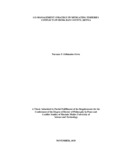| dc.description.abstract | There has been conflict in the fishing industry world over. Fisheries conflicts are among
the persistent problems affecting the security of food, livelihoods and fishing
environments crucial to poor fishing communities in developing countries. In Kenya, the
same has been a major problem and it has taken government’s efforts to curb. One of the
strategies introduced more so in Homa Bay County is the Co-Management Strategy in
which all stakeholders are involved. Although this co-management strategy has been
suggested as a solution to the problem of fisheries use, conflicts still persist. The study
examined the effectiveness of co-management strategy in mitigating fisheries conflicts in
Homa Bay County. It was guided by the following specific objectives: to establish the
effectiveness of Co-Management Strategy in mitigating fisheries conflicts in Homa Bay
County; to find out Community Perception on the Co-Management Strategy in mitigating
fisheries conflicts in Homa Bay County and to establish challenges on the effectiveness
of Co-Management Strategy in mitigating fisheries conflict in Homa Bay County. The
common property theory which assumes that individual interest will not prevail over the
best interest of the community as a whole and Marx’s Conflict Theory which assumes that
Conflict theory states that tensions and conflicts arise when resources, status, and power
are unevenly distributed between groups in society and that these conflicts become the
engine for social change were used in the study. This study was guided by a conceptual
framework derived from common property theory and Marx’s theory of conflict. The
framework was based on the driver-problem-issue- intervention analysis that put into
context the dynamics of variables that addressed the objectives of the study. The research
design used was descriptive in nature. The population of the study was 18, 300 registered
members of BMUs. Multi stage sampling was used to identify two beaches in each of the
five divisions namely: Mfangano, Mbita, Lambwe, Central and Gwassi. Homa Bay
County was selected because it has the largest share of L. Victoria and highest number of
BMUs in the country. The study established that averagely there were about 100 registered
members in each BMU. 40% of BMUs from each of the five divisions were sampled,
resulting to 39 BMUs. From each BMU sampled, 10 registered members were randomly
sampled. The sample size was therefore, 390. The respondents were also clustered as
Fishermen; Boat Owners; Fish Traders and Owners of fishing gears and government
officers. Data was collected using structured questionnaires, interview schedules,
observation and Focus Group Discussions (FGDs). In terms of analysis descriptive
statistics was generated to build a picture of the respondents’ characteristics, this was done
using SPSS. Inferential Statistics used the regression models and ANOVA. The study
found out that Co-Management Strategy mitigates fisheries conflict. The study also found
that the community perception of co-management strategy was positive. Lastly, study also
found that challenges faced by Co-Management strategy were an impediment in the
mitigation of fisheries conflict. The findings of this study support and add knowledge to
previous studies on fisheries conflicts. It is envisaged that the study will contribute to the
field of conflict management within the broader context of co-management strategy in the
fisheries sector, thus leading to harmonious coexistence at the beaches, sustainable
utilization of fisheries resources and improved livelihood of the people.The study suggests
more stakeholders should be involved in the policy formulation and that there should be
more seminars and training of stakeholders. Studies also suggest further research targeting
cultural issues and cross border fishing that is causing fisheries conflicts. | en_US |

